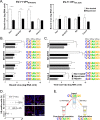A VP1 mutation acquired during an enterovirus 71 disseminated infection confers heparan sulfate binding ability and modulates ex vivo tropism
- PMID: 30075025
- PMCID: PMC6093697
- DOI: 10.1371/journal.ppat.1007190
A VP1 mutation acquired during an enterovirus 71 disseminated infection confers heparan sulfate binding ability and modulates ex vivo tropism
Abstract
Enterovirus 71 (EV71) causes hand, foot and mouth disease, a mild and self-limited illness that is sometimes associated with severe neurological complications. EV71 neurotropic determinants remain ill-defined to date. We previously identified a mutation in the VP1 capsid protein (L97R) that was acquired over the course of a disseminated infection in an immunocompromised host. The mutation was absent in the respiratory tract but was present in the gut (as a mixed population) and in blood and cerebrospinal fluid (as a dominant species). In this study, we demonstrated that this mutation does not alter the dependence of EV71 on the human scavenger receptor class B2 (SCARB2), while it enables the virus to bind to the heparan sulfate (HS) attachment receptor and modifies viral tropism in cell lines and in respiratory, intestinal and neural tissues. Variants with VP197L or VP197R were able to replicate to high levels in intestinal and neural tissues and, to a lesser extent, in respiratory tissues, but their preferred entry site (from the luminal or basal tissue side) differed in respiratory and intestinal tissues and correlated with HS expression levels. These data account for the viral populations sequenced from the patient's respiratory and intestinal samples and suggest that improved dissemination, resulting from an acquired ability to bind HS, rather than specific neurotropism determinants, enabled the virus to reach and infect the central nervous system. Finally, we showed that iota-carrageenan, a highly sulfated polysaccharide, efficiently blocks the replication of HS-dependent variants in cells and 2D neural cultures. Overall, the results of this study emphasize the importance of HS binding in EV71 pathogenesis and open new avenues for the development of antiviral molecules that may prevent this virus's dissemination.
Conflict of interest statement
SH and SC are employees of Epithelix Sàrl. There is no other relevant information linked to this affiliation that presents any conflict of interest. Moreover, we confirm that this affiliation does not alter our adherence to all PLOS Pathogens policies on sharing data and materials.
Figures







References
-
- Brown BA, Pallansch MA. Complete nucleotide sequence of enterovirus 71 is distinct from poliovirus. Virus Res. 1995;39(2–3):195–205. . - PubMed
-
- Melnick JL. Enterovirus type 71 infections: a varied clinical pattern sometimes mimicking paralytic poliomyelitis. Rev Infect Dis. 1984;6 Suppl 2:S387–90. . - PubMed
-
- Chan LG, Parashar UD, Lye MS, Ong FG, Zaki SR, Alexander JP, et al. Deaths of children during an outbreak of hand, foot, and mouth disease in sarawak, malaysia: clinical and pathological characteristics of the disease. For the Outbreak Study Group. Clin Infect Dis. 2000;31(3):678–83. 10.1086/314032 . - DOI - PubMed
Publication types
MeSH terms
Substances
LinkOut - more resources
Full Text Sources
Other Literature Sources
Research Materials
Miscellaneous

